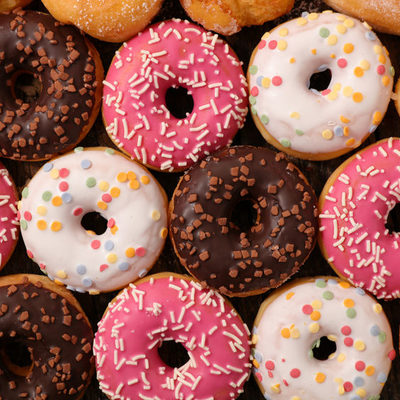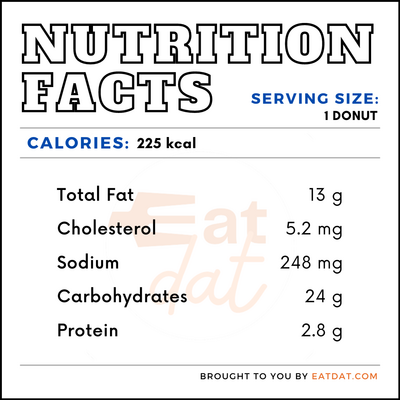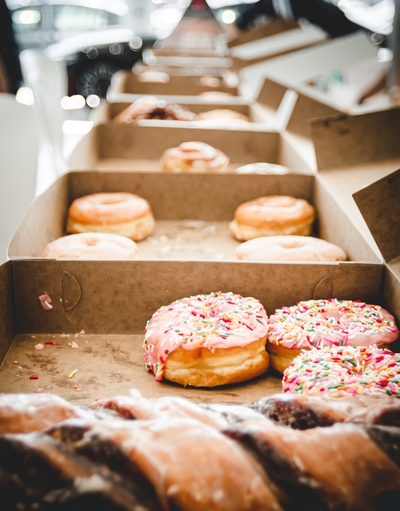
Donuts
Also known as Doughnuts, do-nuts, fried bread, Paczki, Bismark, Berliner
What is a donut?
A donut or doughnut is a sweet confection made of fried dough commonly eaten for breakfast or dessert.
- This fried pastry is widely available for consumption at bakeries, coffee shops, and supermarkets.
- Donuts come in two varieties, cake or yeast, and are sold in an array of flavors, glazes, and toppings.
Yeast raised donuts are more popular as fresh offerings, while cake donuts are better for shelf life longevity. This sweet pastry even has a holiday, celebrated on the first Friday of June every year. In the United States, over 10 billion donuts are made each year.
The top 9 best donut chains in the US, according to The Daily Meal are:
- Top Pot Doughnuts
- LaMar’s Donuts
- Shipley Do-Nuts
- Winchell’s Donut House
- Daylight Donuts
- Honey Dew Donuts
- Tim Horton’s
- Krispy Kreme
- Dunkin’ Donuts
Origin
As a food that has left traces all over the globe, the exact origin of this pastry is not entirely clear. However, in the 1800s the Dutch were making olykoeks—a ball of cake stuffed with fruits or nuts and fried in pork fat. In 1847, a ship captain named Hansen Gregory punched a hole in these “oily cakes” and invented the donut. Later in 1898, a German immigrant named William Entenmann opened the first bakery in Brooklyn and delivered pastries, including donuts, door-to-door. This fried pastry didn’t reach its famous status until the end of World War I when it was served to soldiers and volunteers alike.
By 1920, an entrepreneur named Adolph Levitt invented the first automated donut-making machine. At the Chicago World’s Fair of 1934, this sweet treat was promoted as “the food hit of the Century of Progress.” A few years later, Krispy Kreme was already manufacturing this pastry to sell in supermarkets across the country. In time, the recipe continued to evolve and in the 1970s the chocolate-covered cake donut was born. Today, you can find America’s favorite pastry just about anywhere in a plethora of varieties, flavors, and sizes.
Nutrition
While these doughy treats can brighten up any morning, indulging in them too much can pile on the pounds. A plain cake donut has:

Cream filling, glaze, and other toppings will only increase the caloric values of this sweet treat. Nutritionists recommend cutting down on fried pastries to maintain a healthy diet and avoid heart disease, high blood pressure, and diabetes.
Commercial production
The commercial production for cake and yeast donuts varies between the types. For the cake variety, the ingredients are mixed to create a batter that is poured into a machine. This machine shapes the pastry and then drops it into hot oil to fry. Frying only lasts for a minute and a half, then the donuts are left to cool before being decorated and then packaged or served.
The yeast variety requires more time to prepare. After being mixed, the yeast dough is laid out on sheets and sent through a series of rollers to be flattened. The flattened dough is seasoned with cinnamon then rolled into a log shape, flatted again, then cut into discs. These discs are sent to a proofer to rise before they are fried evenly on both sides and glazed. The excess glaze is blown off as the donuts cool and eventually make their way to be packaged and stored until shipping.
Varieties of Donuts

Here are some popular varieties of this sweet pastry.
- Cruller – Fusing cake and yeast donut recipes, the eggy cruller brings the best of both worlds. This swirl-shaped ring can be found with a honey or vanilla glaze.
- Jelly donut – A juicy spin on the classic, this fried pastry is filled with fruit jelly. Some variations of this treat include Berliners, bomboloni, paczki, and sufganiyot.
- Cream-filled doughnut – Similar to its jelly-filled cousin, this donut features a luscious cream filling instead of a fruit jelly or jam.
- Boston cream – Also known as a Bismark, this yeast donut is the ultimate treat for a sweet tooth. A Boston cream is full of custard and topped with chocolate!
- Donut holes – These small doughy balls are often made from leftover dough. Donut hole toppings are as creative as doughnuts and can be glazed, sugared, or stuffed.
- Beignet – This French-inspired yeast doughnut is made of choux pastry which puffs up when fried. Fritters are often deliciously served with powdered sugar on top.
- Churros – Born in Spain and still very popular in Spanish-speaking countries, this friend choux pastry has quite the reputation. Find it topped with sugar or stuffed with cream or even dulce de leche.
- Fritter – This fried dough ball aims to please. Choose between sweet fruit stuffings and glaze or savory stuffings such as crab or cheese.
- Cider – These cake donuts encompass the spirit of autumn as they’re infused with apple cider and topped with cinnamon or sugar. You’ll also find them with a light glaze.
- Long John – Reminiscent of an eclair, this doughy treat is a rectangular shape. This baked, yeast treat comes in a maple glaze, frosted, or stuffed with jelly or custard.
- Twists – This twirly doughnut features a tasty cinnamon glaze and fun-to-eat shape. You can also find twists with classic, chocolate, or maple glaze.
- Malasadas – Of Portuguese origin, these sweet treats have a history of pleasing crowds. Crafted from leavened dough and rolled in sugar, you can find these pastries plain or filled with fruit jelly or custard, as well.
- Potato doughnuts – While these have a similar texture to donuts, they’re actually made from mashed potatoes instead of flour. These are also known as Spudnuts.
- Zeppole – Hailing from Italy, the zeppole is the treat grandmas make. This fluffy fried dough can be enjoyed covered in powdered sugar or filled with custard or chocolate
Uses
Donuts are tastiest when they are hot and freshly baked, but leftovers can be just as nice. To keep this pastry from going stale, you must store them correctly. When this pastry is cream-filled, it should be stored in the refrigerator and kept for only 3-4 days. Keeping it in the freezer can increase that time up to three months. Cake and glazed donuts can be stored at room temperature in an air-tight container. You can also place these in the refrigerator or freezer if you don’t plan to eat them the following day.
Donut Recipes
This sweet pastry is a breakfast time favorite. Here are some popular recipes.
FDA Regulation
The Food & Drug Administration requires that any companies producing donuts follow their labeling regulations. Labels must include serving sizes and reference amounts for each distinct piece. The FDA also requires that food establishments that serve these pastries declare the calories for each flavor or variety.
References
Taylor, David A. “The History of the Doughnut.” Smithsonianmag.com, Smithsonian Magazine, 1 Mar. 1998, www.smithsonianmag.com/history/the-history-of-the-doughnut-150405177/.
Holdefehr, Katie. “A Short but Sweet History of Donuts.” Goodhouskeeping.com, Good Housekeeping, 21 Mar. 2018, www.goodhousekeeping.com/institute/a18569/history-donuts-in-america/.
“Which Foods Don’t Belong in a Healthy Diet?” Health.harvard.edu, Harvard Health Publishing , www.health.harvard.edu/staying-healthy/which-foods-dont-belong-in-a-healthy-diet.
“CFR – Code of Federal Regulations Title 21.” Accessdata.fda.gov, U.S. Food & Drug Administration, 1 Apr. 2019, www.accessdata.fda.gov/scripts/cdrh/cfdocs/cfcfr/cfrsearch.cfm?fr=101.12.
